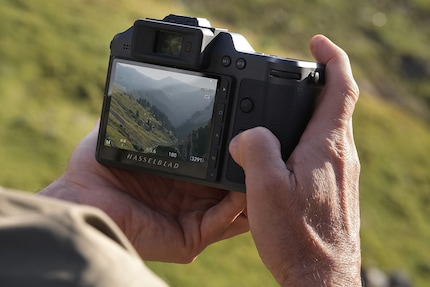
Hasselblad presents the X2D II: LiDAR autofocus and HDR
The new compact medium format camera from Hasselblad offers a resolution of 100 megapixels, HDR images and an innovative autofocus. Compared to its predecessor, it also improves operation and the image stabiliser - and costs less.
Hasselblad has unveiled the fourth version of its mirrorless medium format camera. The X2D II 100C uses the same 100-megapixel sensor as its predecessor, but is said to bring significant advances in other areas: Autofocus, image stabiliser and HDR shooting. The Swedish manufacturer continues to do without a video function.
The form factor of the aluminium unibody remains unchanged. However, a joystick and an additional thumb button have been added to the controls on the back. And the settings wheel on the top is also a button. In addition, the handle is made of a new material that should provide more grip. The colour of the housing this time is «graphite grey».

Source: Hasselblad
The price of the Hasselblad X2D II is fortunately lower than that of the old model. It costs 7200 francs or euros - around 1800 francs or 1500 euros less than the X2D when it was launched three years ago. The first units are due to be delivered at the end of September. Whether and when the camera will be available here is still unclear.
Autofocus with LiDAR
Autofocus was an Achilles heel of Hasselblad's previous cameras. With the X2D II, the manufacturer not only wants to catch up with Fujifilm's medium format competition, but is also bringing a real innovation to the market: the new system uses a LiDAR (Light Distance and Ranging) sensor - in addition to 425 phase detection points. The LiDAR technology probably comes from DJI, the Chinese majority owner of Hasselblad. It measures the distance with light, similar to how a radar measures it with radio waves.
On the software side, the X2D II recognises people, faces and eyes, as well as cats, dogs and vehicles. The first test reports see the autofocus as a major improvement on that of the old X2D - it is faster, more sophisticated and more reliable. In addition, in AF-C mode it can finally track the focus continuously. However, Hasselblad's autofocus does not come close to the level of a good full-frame camera.
Industry-leading IBIS?
The Hasselblad X2D already had a good image stabiliser (IBIS), which reduces camera shake by up to 7 exposure stops. The X2D II apparently goes one step further: the new IBIS is said to be able to achieve up to 10 stops. That would be a record, and not only in medium format. The Swedish manufacturer says that shutter speeds of several seconds are possible from the hand.
The first practical tests conclude that the stabiliser is indeed an improvement on the previous model. How much better than other systems is not conclusively clear from the specifications. This is because the official specification comes with small print: it is the CIPA rating in the centre of the image. At the edges of the image, the IBIS «only compensates» eight stops.
Hasselblad ventures into HDR
Similar to current smartphones, the X2D can take pictures in HDR - and also display them: both the viewfinder and the OLED display on the back now support the DCI-P3 colour space and have a peak brightness of 1400 nits. This is also a pioneering achievement for «large» cameras, something that Sony, Canon and the like have not yet dared to do.

Source: Hasselblad
JPGs and HEIFs can be saved natively in the HDR colour space. If you then view them on an HDR-capable display such as an iPhone, for example, they will be displayed correctly. If you want to use HDR in raw format, you must then develop the files with Hasselblad's own RAW converter Phocus. It is not possible via Lightroom.
New lens: XCD 35-100mm f/2.8-4 E
Together with the camera, Hasselblad is introducing a new standard zoom, the XCD 35-100mm f2.8-4 E. It is one of the fastest medium format zooms. The letter E stands for the Exclusive series, which is synonymous with top quality. The zoom range corresponds to 28 to 76 millimetres in full format, the aperture is around f/2.2 to f/3.2. The lens weighs 894 grams and costs 4800 francs or euros.
My fingerprint often changes so drastically that my MacBook doesn't recognise it anymore. The reason? If I'm not clinging to a monitor or camera, I'm probably clinging to a rockface by the tips of my fingers.
From the latest iPhone to the return of 80s fashion. The editorial team will help you make sense of it all.
Show all